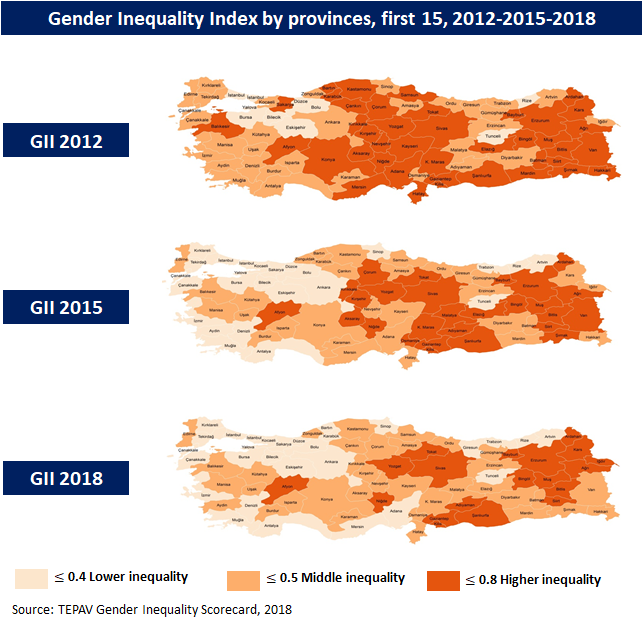The gender gap is narrowing in Turkey
Last week, TEPAV announced its third Gender Inequality Scorecard. Our objective here is to raise awareness about gender inequality in the Turkish countryside. The results are surprising this year. After the 2012 and 2015 reports, there is significant improvement across the board in gender equality. We collect data on the provincial level, and the best performing are Van, Tunceli, Antalya, Maraş and Artvin. Except Antalya, all of these provinces are in the East.
The study was conducted by applying the UNDP’s Gender Inequality Index (GII) methodology used in Human Development Reports. The UNDP’s GII covers the employment, health, education and political representation of women. It’s basically about social inclusion. Having a formal education, a job, and no children at an early age, together with political representation, lowers gender inequality. Despite what clickbait journalism might have you believe, that’s what has been happening in Turkish provinces from 2012 to 2018.

Don’t get me wrong. I am not saying that all is well. It’s not. Let me start with the numbers. In 2009, employment of those aged 15-74 in Turkey was 40 percent, with female labor force participation being around 23.5 percent. As of 2016, employment of those aged between 15-74 in Turkey is only at 48 percent, which is significantly lower than OECD average of 61 percent. This is partly due to a low rate of female employment at 27.9 percent, which in the OECD is around 48 percent. So Turkey is still not doing well when compared to rich economies, but it has made significant progress.
Take a look at unemployment rate in the country. It is now around 10.3 percent in total. Yet when you look at the 20-24 age cohort, it reaches 21.50 percent, being 18.3 percent for young males and 26.8 percent for young females. The latter are better educated than their male counterparts, trying to use all the mechanisms provided by Turkish Employment Agency to find a job, too many fail. This is often because of their social role as women.
Then have a look at the fertility rate of women. Births per woman have declined from 2.15 in 2011, to 2.10 in 2016. If you go back to 1960, it was 6.5. Urbanization rate was around 30 percent back in the 1960s, now it has reached around 75 percent. Despite the political rhetoric about having 3 children in the last 15 years, Turkish women know what they are doing. Urbanization gets more and more girls out of the house, into schools, and less likely to have many children.
When it comes to the UNDP’s GII, Turkey is 69 out of 159 countries in the 2015 index. Turkey is still no easy place for women. We are the 16th largest economy of the world, yet 69th when it comes to gender equality. Only 14.9 percent of parliamentary seats are held by women. 43.5 percent of adult women have reached at least a secondary level of education compared to 64.8 percent of their male counterparts.
Local GII data compiled by TEPAV indicates that the situation is gradually but consistently changing around the country, especially in the East. Why? The largest impact between 2012 to 2018 has been coming from the increasing representation of women in local municipal councils. More women are elected in local elections now. I first had the idea that it might be related to the Kurdish reconciliation process and the greater number of female HDP local councilors in the south east. Yet a closer look reveals that the improvements reach far beyond that. Perhaps the debate around wearing headscarves at universities set the trend for strong women on the right of the political spectrum. What’s sure is that slowly but surely, women are coming out of their homes in Turkey. All is not as it appears.
This commentary was published in Hürriyet Daily News on 10.03.2018




